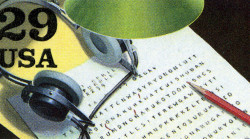Tracie Spinale
Learning Programs Manager
Smithsonian Institution
Middle School (13 to 15 years old), High School (16 to 18 years old), Post-Secondary
Teacher/Educator, Curriculum Coordinator, Parent, Museum Staff
Language Arts And English, Science, Social Studies, Arts, Special Education, Career and Tech Ed, Other
: Museum Studies
Hi there! I am the Learning Programs Manager at the Office of the Under Secretary for Education (OUSE) where I focus on positive youth development programs.
Enjoy!
- Positive Youth Development
- 4-H & 4-H Guide to the Smithsonian booklet
- Boys & Girls Clubs of America
- All Access Digital Arts Program - Collections for teens and youth with cognitive differences
- Distance Learning Resources
- A cultural science series from the Smithsonian Arctic Studies Center in Alaska (#arcticstudies)
- Maker and activity collections about environmental and social justice issues
- Topical collections
- A series on the intersection of Buddhism and Western Science
Tracie Spinale's collections
"The World of Your Senses": Parallel Perspectives from Tibetan Buddhism and Western Science on Sensory Perception
<p>"The World of Your Senses" shares parallel perspectives from Tibetan Buddhism and western science on sensory perception. This collection explores the questions: How do we see? How does hearing work? How do we perceive smell? How does taste function? How do we sense touch? In addition, the Buddhist perspective includes a sixth sense... mind consciousness!</p>
<p>"The World of Your Senses" is the result of many years of work growing out of directives from His Holiness the Dalai Lama and his long history engaging Western scientists in dialogue. The script, content, and imagery were envisioned by a dedicated and curiosity-filled group of thirty Tibetan Buddhist monastics-in-exile from monasteries and nunneries in India, through the "Science for Monks and Nuns" program. The creation of the physical exhibit, launched in 2010, was supported through a unique collaboration between the Library of Tibetan Works and Archives (LWTA in Dharamsala, India), the Sager Family Foundation, the Smithsonian Institution in Washington, D.C. (SCEMS/SCLDA/OET & OEC/Smithsonian Exhibitions), and the Exploratorium in San Francisco. It has since traveled to the United States, Nepal, and Bhutan.</p>
<p>The resource is bi-lingual: English and Tibetan.</p>
<p>RELATED COLLECTIONS:</p>
<p>Senses Series – <strong><a href="http://learninglab.si.edu/q/ll-c/n2f39XxkfBRJeHPk" target="_blank">Sight in Humans and Animals</a></strong> (<a href="http://learninglab.si.edu/q/ll-c/n2f39XxkfBRJeHPk">http://learninglab.si.edu/q/ll-c/n2f39XxkfBRJeHPk</a>)<br><br>Senses Series – <strong><a href="http://learninglab.si.edu/q/ll-c/7EbVTM49NgWiGrzA" target="_blank">Hearing</a></strong> (<a href="http://learninglab.si.edu/q/ll-c/7EbVTM49NgWiGrzA">http://learninglab.si.edu/q/ll-c/7EbVTM49NgWiGrzA</a>)<br><br>Senses Series – <strong><a href="http://learninglab.si.edu/q/ll-c/7LjjBHybUk9HE8Wj" target="_blank">Smell</a> </strong>(<a href="http://learninglab.si.edu/q/ll-c/7LjjBHybUk9HE8Wj">http://learninglab.si.edu/q/ll-c/7LjjBHybUk9HE8Wj</a>)<br><br>Senses Series – <strong><a href="http://learninglab.si.edu/q/ll-c/2w7r7PVoAgghiYmL" target="_blank">Taste</a> </strong> (<a href="http://learninglab.si.edu/q/ll-c/2w7r7PVoAgghiYmL" style="background-color:rgb(63,63,63);">http://learninglab.si.edu/q/ll-c/2w7r7PVoAgghiYmL</a>)<br><br>Senses Series – <strong><a href="http://learninglab.si.edu/q/ll-c/oon5rHojeyrEwNEE" target="_blank">Touch</a> </strong>(<a href="http://learninglab.si.edu/q/ll-c/oon5rHojeyrEwNEE" style="background-color:rgb(63,63,63);">http://learninglab.si.edu/q/ll-c/oon5rHojeyrEwNEE</a>)</p>
<p><br>This collection is based Science For Monks, <a href="http://scienceformonks.org/world-of-your-senses-web-tour/" target="_blank">World of Your Senses</a> (2010).</p>
 Tracie Spinale
Tracie Spinale
28
Senses Series - Hearing
<p>How do we hear what we hear? This collection is about hearing the world in unexpected ways through human perspectives of science and culture, and animal adaptations. Meet a shark whose entire body is an ear; zoo otters who play the keyboard; rabbits whose large ear adaptations provide self-defense; and the reasons for a sea lion's bark. Learn about the structure and function of human ears can only see a certain type of light within the electromagnetic spectrum. Background information from the website Neuroscience for Kids provides an overview of how the ear and hearing functions work, as well as a sound experiments to try. The collections closes with a cross-cultural examination of hearing and function from Tibetan Buddhist monastics.<br /><br />Based on exhibition project work through <a href="http://scienceformonks.org/">Science for Monks</a> and <a href="http://scienceformonks.org/world-of-your-senses-web-tour/" target="_blank">The World of Your Senses</a> Exhibition (2010).</p>
 Tracie Spinale
Tracie Spinale
10
Senses Series - Sight in Humans and Animals
<p>How do we see what we see? This collection is about seeing the world in unexpected ways through human innovations and animal adaptations. Meet a teen who invented a new way to see infrared, a visually impaired woman with a bionic implant, a shark whose eye is similar our own, a Giant Squid with the world's largest eyes, a mantis shrimp who sees many colors in all directions, and a nocturnal sweat bee who navigates the jungle in the dark. Learn about why human vision can only see a certain type of light within the electromagnetic spectrum. Background information from the website Neuroscience for Kids provides an overview of how the eye and brain function together, and experiments to try. The collection concludes with a cross-cultural examination of seeing from a Tibetan monastic Buddhist perspective. How might their experience of sight differ from your own? <br /><br />Based on exhibition project work through <a href="http://scienceformonks.org/">Science for Monks</a> and <a href="http://scienceformonks.org/world-of-your-senses-web-tour/" target="_blank">The World of Your Senses</a> Exhibition (2010).</p>
 Tracie Spinale
Tracie Spinale
15
"Think Different": Steve Jobs
<p>What does it mean to be influenced by the world around you? This collection looks at the technical innovations, design influences (Japanese Zen Buddhist, Italian, Bauhaus); location influences (Yosemite, Silicon Valley); and cultural and musical influences (Bob Dylan, Edwin Land) which inspired Steve Jobs to "think different" and create digital products which changed the world.<br></p><p>Today, owning an iPhone is almost ubiquitous--seamlessly integrated into our modern lives. I'm typing on a MacBook Pro as I write this metadata note. But, I'll always remember the feeling of excitement as a kid--my first personal computer, an Apple //c. (1984). I spent hours, upon hours on it, exploring a strange and wonderful new world; and years later, a Macintosh followed, that took me to college. I remember wearing earbuds for the first time, and listening to my personal music collection on my first iPod Gen 4 (2004). Besides being a seminal technology influence in my life, I was inspired to create this collection about Steve Jobs after creating a family day program at the Smithsonian based on the <em><a href="https://www.si.edu/Exhibitions/The-Patents-and-Trademarks-of-Steve-Jobs-Art-and-Technology-that-Changed-the-World-4838" target="_blank">Patents and Trademarks of Steve Job</a></em> traveling exhibition (2012). I hope the story of Jobs and Apple inspires the next generation to think different and change the world through technology.</p>
<p>Keywords: inventor, biography, technology, innovation</p>
 Tracie Spinale
Tracie Spinale
42
Color Series - Green
<p>This topical collection of the color green is part of a color series and was originally used in a collage art activity (printed out; using paper, glue, and art materials) with a group of teens with cognitive disabilities during a summer camp program. I was inspired to create the series after a few of our students mentioned their passionate interest in specific colors, and how they thought in colors.</p>
<p>Tags: color series, decision-making, self-determination, student empowerment, disability, All Access Digital Arts Program</p>
 Tracie Spinale
Tracie Spinale
30
Color Series: Yellow
<p>This topical collection of the color yellow is part of a color series and was originally used in a collage art activity (printed out; using paper, glue, and art materials) with a group of teens with cognitive disabilities during a summer camp program. I was inspired to create the series after a few of our students mentioned their passionate interest in specific colors, and how they thought in colors<br></p>
<p>Tags: color series, decision-making, self-determination, student empowerment, disability, All Access Digital Arts Program</p>
 Tracie Spinale
Tracie Spinale
30
Access Series: People, Friends, and Family--Together and Alone
<p>This topical collection of people—together in groups with friends or families (mother, father, sister, brother, aunt, uncle, cousin, grandmother, and grandfather); different genders, ages, and ethnicities, and "selfies"—was originally used in a collage art activity (printed out; using paper, glue, and art materials); and as a discussion prompt in an informal learning activity with a group of teens with cognitive disabilities during a summer camp program. Use the visible thinking routine, "See|Think|Wonder" and Conversing with Objects discussion prompt as a starting point for the writing prompt, and the images for inspiration. </p>
<p>Tags: decision-making, self-determination, student empowerment, disability, All Access Digital Arts Program, teens in museums, teens, teenagers, after school, out of school learning, informal learning</p>
 Tracie Spinale
Tracie Spinale
118
Access Series: Animals - Domestic and Wild!
<p>This topical collection of artworks is all about animals—domestic pets, and wild, untamed beasts. Horses, elephants, dinosaurs, zebras, pandas...cats, hogs, frogs, dogs, lions, tigers, and bears; fish and fowl, monkeys that howl - you'll find all of them here. This collections was originally used in a collage art activity (printed out; using paper, glue, and art materials), and as a discussion prompt in an informal learning activity with a group of teens with cognitive disabilities during a summer camp program. <br><br>Other suggested uses beyond collage and discussion prompts would be a writing exercise, "Which animals have you seen before and where did you see them? If you could have any one of these animals as a pet, which would you choose and why?" Use the visible thinking routine, "See|Think|Wonder" as a starting point for the writing prompt, and the images for inspiration. Also included is a lesson plan which could be adapted for a visit to a natural history museum or zoo.</p>
<p><br> Tags: Decision Making, Disabilities, Self-Determination, Self-Efficacy, Student Empowerment, All Access Digital Arts Program, teens in museums, teens, teenagers, after school, out of school learning, informal learning</p>
 Tracie Spinale
Tracie Spinale
215
Access Series: Places "Real" and "Imagined"
<p>Covid-19 has all but put an end to the days of carefree and open travel. However, that doesn't mean that we cannot let our minds wander! </p><p>This topical collection of artworks is based upon a wide variety of places and travel spots, both "real" and "imagined." It features castles, mountains, beaches, forests, capital cities, and fantasy movie landscapes. It was originally used in a collage art activity (printed out; using paper, glue, and art materials); and as a discussion prompt in an informal learning activity with a group of teens with cognitive disabilities during a summer camp program. Students were asked about famous places they have visited or would want to visit, as well as favorite vacation or travel spots. <br><br>Other suggested uses beyond collage and discussion prompts would be a writing exercise, "If you could travel anywhere, where would you go, and who would you travel with, etc...?" Use the visible thinking routine "See|Think|Wonder" as a starting point for the writing prompt, and the images for inspiration.<br><br>Tags: Decision Making, Disabilities, Self-Determination, Self-Efficacy, Student Empowerment, All Access Digital Arts Program, teens in museums, teens, teenagers, after school, out of school learning, informal learning</p>
 Tracie Spinale
Tracie Spinale
56
Access Series: Fantastic Creatures
<p>This topical collection of artworks is based upon "fantastical creatures." It was originally used in a collage art activity (printed out; using paper, glue, and art materials); and as a discussion prompt in an informal learning activity with a group of teens with cognitive disabilities during a summer camp program. <br></p>
<p>Other suggested uses beyond collage and discussion prompts would be a writing exercise, utilizing the "See|Think|Wonder" visible thinking routine or the “Conversing with an Object” discussion prompt as writing inspiration. You could also pair the collection with popular young adult fantasy novels, and ancient myths and legends. Or draw your own fantastic creature.<br><br> Descriptors: Decision Making, Disabilities, Self-Determination, Self-Efficacy, Student Empowerment, All Access Digital Arts Program, teens in museums, teens, teenagers, after school, out of school learning, informal learning</p>
 Tracie Spinale
Tracie Spinale
41
Color Series: Pink
<p>This topical collection of the color pink is part of a color series and was originally used in a collage art activity (printed out; using paper, glue, and art materials) with a group of teens with cognitive disabilities during a summer camp program. </p>
<p>Tags: color series, decision-making, self-determination, student empowerment, disability, All Access Digital Arts Program</p>
 Tracie Spinale
Tracie Spinale
30
Access Series: Collage
<p>This topical collection of artworks is all about collage. Collage is a technique that uses other pieces of artwork assembled into a new artwork. </p>
<p>The collection was originally used in a collage art activity to provide inspiration examples of the art of collage-making, based upon personal interests. It was used with a group of teens with cognitive disabilities during a summer camp program. <br><br> Descriptors: Decision Making, Disabilities, Self-Determination, Self-Efficacy, Student Empowerment, teens in museums, teens, teenagers, after school, out of school learning, informal learning</p>
 Tracie Spinale
Tracie Spinale
29
























